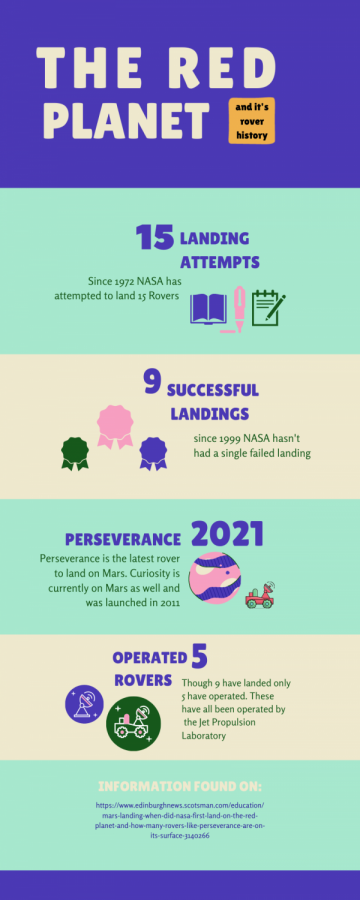
Some have spent years wondering what it is like beyond earth and because of many advancements in technology, finding out has finally been made possible. Feb. 18, 2021, nearly 24 years after the first rover landed on Mars, NASA landed a rover known by the name of Perseverance. Perseverance is one of five rovers that have been successfully landed on the mysterious planet. However, this landing is marked as historical for many reasons.
NASA has listed four goals in landing the Rover. The first to discover if life ever existed on Mars. The second goal is to characterize the climate, the third to characterize the geology of Mars, and the fourth, to prepare for human exploration. As Mars’ environment is explored, NASA hopes to understand how to protect future human explorers.
“I think it is a fantastic testament to human engineering and the desire to discover,” said Shane Barry, physics teacher.
As Perseverance took its place on the famous planet, NASA broadcasted the landing from Mission Control at 2:15 pm EST. This allowed people of all ages to take part in the direction of space exploration.
In a news conference Micheal Watkins, a scientist and engineer for NASA stated that this is the first time they have been able to capture an event such as this.
“The publicity for NASA is great, they need that type of press to continue to get the funding required for future missions,” said Barry. “It could impact the world as it gathers data, but at this point, it is hard to say what will come of the information that is coming in.”
Now that the rover has landed, NASA is working to release information to the public in a timely manner so that individuals worldwide have the opportunity to view and learn from everything Mars has to offer. NASA plans to release images captured by Perseverance as well as sound.
“I think that the discoveries will help to increase our limited understanding of space and hopefully we’ll be able to discover more with the information we receive,” said Natalie Hignite, junior.
More information on Perseverance can be found on NASA’s official website including facts, pictures, and sound.






